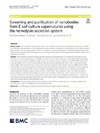Identificador persistente para citar o vincular este elemento:
https://accedacris.ulpgc.es/jspui/handle/10553/69843
| Título: | Screening and purification of nanobodies from E. coli culture supernatants using the hemolysin secretion system | Autores/as: | Ruano-Gallego, David Fraile, Sofía Gutiérrez Cabrera, Carlos Javier Fernández, Luis Ángel |
Clasificación UNESCO: | 310907 Patología 310801 Bacterias |
Palabras clave: | E. Coli/Hemolysin Nanobodies Protein Secretion Single-Domain Antibodies |
Fecha de publicación: | 2019 | Publicación seriada: | Microbial Cell Factories | Resumen: | The hemolysin (Hly) secretion system of E. coli allows the one-step translocation of hemolysin A (HlyA) from the bacterial cytoplasm to the extracellular medium, without a periplasmic intermediate. In this work, we investigate whether the Hly secretion system of E. coli is competent to secrete a repertoire of functional single-domain VHH antibodies (nanobodies, Nbs), facilitating direct screening of VHH libraries and the purification of selected Nb from the extracellular medium. Results: We employed a phagemid library of VHHs obtained by immunization of a dromedary with three protein antigens from enterohemorrhagic E. coli (EHEC), namely, the extracellular secreted protein A (EspA), the extracellular C-terminal region of Intimin (Int280), and the translocated intimin receptor middle domain (TirM). VHH clones binding each antigen were enriched and amplified by biopanning, and subsequently fused to the C-terminal secretion signal of HlyA to be expressed and secreted in a E. coli strain carrying the Hly export machinery (HlyB, HlyD and TolC). Individual E. coli clones were grown and induced in 96-well microtiter plates, and the supernatants of the producing cultures directly used in ELISA for detection of Nbs binding EspA, Int280 and TirM. A set of Nb sequences specifically binding each of these antigens were identified, indicating that the Hly system is able to secrete a diversity of functional Nbs. We performed thiol alkylation assays demonstrating that Nbs are correctly oxidized upon secretion, forming disulphide bonds between cysteine pairs despite the absence of a periplasmic intermediate. In addition, we show that the secreted Nb-HlyA fusions can be directly purified from the supernatant of E. coli cultures, avoiding cell lysis and in a single affinity chromatography step. Conclusions: Our data demonstrate the Hly secretion system of E. coli can be used as an expression platform for screening and purification of Nb binders from VHH repertories.[Figure not available: see fulltext.] | URI: | https://accedacris.ulpgc.es/handle/10553/69843 | DOI: | 10.1186/s12934-019-1094-0 | Fuente: | Microbial Cell Factories, v. 18 (1) |
| Colección: | Artículos |
Citas SCOPUSTM
42
actualizado el 08-jun-2025
Citas de WEB OF SCIENCETM
Citations
37
actualizado el 08-jun-2025
Visitas
175
actualizado el 31-may-2025
Descargas
182
actualizado el 31-may-2025
Google ScholarTM
Verifica
Altmetric
Comparte
Exporta metadatos
Los elementos en ULPGC accedaCRIS están protegidos por derechos de autor con todos los derechos reservados, a menos que se indique lo contrario.
